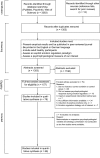Psychophysiological Effects of Downregulating Negative Emotions: Insights From a Meta-Analysis of Healthy Adults
- PMID: 32372993
- PMCID: PMC7177019
- DOI: 10.3389/fpsyg.2020.00470
Psychophysiological Effects of Downregulating Negative Emotions: Insights From a Meta-Analysis of Healthy Adults
Abstract
Assessing psychophysiological responses of emotion regulation is a cost-efficient way to quantify emotion regulation and to complement subjective report that may be biased. Previous studies have revealed inconsistent results complicating a sound interpretation of these findings. In the present study, we summarized the existing literature through a systematic search of articles. Meta-analyses were used to evaluate effect sizes of instructed downregulation strategies on common autonomic (electrodermal, respiratory, cardiovascular, and pupillometric) and electromyographic (corrugator activity, emotion-modulated startle) measures. Moderator analyses were conducted, with moderators including study design, emotion induction, control instruction and trial duration. We identified k = 78 studies each contributing multiple sub-samples and performed 23 meta-analyses for combinations of emotion regulation strategy and psychophysiological measure. Overall, results showed that effects of reappraisal and suppression on autonomic measures were highly inconsistent across studies with rather small mean effect sizes. Electromyography (startle and corrugator activity) showed medium effect sizes that were consistent across studies. Our findings highlight the diversity as well as the low level of standardization and comparability of research in this area. Significant moderation of effects by study design, trial duration, and control condition emphasizes the need for better standardization of methods. In addition, the small mean effect sizes resulting from our analyses on autonomic measures should be interpreted with caution. Findings corroborate the importance of multi-channel approaches.
Keywords: autonomic nervous system; electromyography; emotion regulation; meta-analysis; psychophysiology; reappraisal; suppression.
Copyright © 2020 Zaehringer, Jennen-Steinmetz, Schmahl, Ende and Paret.
Figures



References
Publication types
LinkOut - more resources
Full Text Sources

